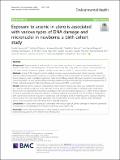Exposure to arsenic in utero is associated with various types of DNA damage and micronuclei in newborns: a birth cohort study
Author(s)
Navasumrit, Panida; Chaisatra, Krittinee; Promvijit, Jeerawan; Parnlob, Varabhorn; Waraprasit, Somchamai; Chompoobut, Chalida; Binh, Ta T; Hai, Doan N; Bao, Nguyen D; Hai, Nguyen K; Kim, Kyoung-Woong; Samson, Leona D; Graziano, Joseph H; Mahidol, Chulabhorn; ... Show more Show less
Download12940_2019_Article_481.pdf (786.6Kb)
Publisher with Creative Commons License
Publisher with Creative Commons License
Creative Commons Attribution
Terms of use
Metadata
Show full item recordAbstract
BACKGROUND: Growing evidence indicates that in utero arsenic exposures in humans may increase the risk of adverse health effects and development of diseases later in life. This study aimed to evaluate potential health risks of in utero arsenic exposure on genetic damage in newborns in relation to maternal arsenic exposure. METHODS: A total of 205 pregnant women residing in arsenic-contaminated areas in Hanam province, Vietnam, were recruited. Prenatal arsenic exposure was determined by arsenic concentration in mother’s toenails and urine during pregnancy and in umbilical cord blood collected at delivery. Genetic damage in newborns was assessed by various biomarkers of early genetic effects including oxidative/nitrative DNA damage (8-hydroxydeoxyguanosine, 8-OHdG, and 8-nitroguanine), DNA strand breaks and micronuclei (MN) in cord blood. RESULTS: Maternal arsenic exposure, measured by arsenic levels in toenails and urine, was significantly increased (p < 0.05) in subjects residing in areas with high levels of arsenic contamination in drinking water. Cord blood arsenic level was significantly increased in accordance with maternal arsenic exposure (p < 0.001). Arsenic exposure in utero is associated with genotoxic effects in newborns indicated as increased levels of 8-OHdG, 8-nitroguanine, DNA strand breaks and MN frequency in cord blood with increasing levels of maternal arsenic exposure. Maternal toenail arsenic level was significantly associated with all biomarkers of early genetic effects, while cord blood arsenic levels associated with DNA strand breaks and MN frequency. CONCLUSIONS: In utero arsenic exposure is associated with various types of genetic damage in newborns potentially contributing to the development of diseases, including cancer, later in life.
Date issued
2019-06-07Department
Massachusetts Institute of Technology. Center for Environmental Health SciencesJournal
Environmental Health
Publisher
BioMed Central
Citation
Navasumrit, Panida et al. "Exposure to arsenic in utero is associated with various types of DNA damage and micronuclei in newborns: a birth cohort study." Environmental Health 18 (June 2019): no. 51 doi https://doi.org/10.1186/s12940-019-0481-7 ©2019 Author(s)
Version: Final published version
ISSN
1476-069X